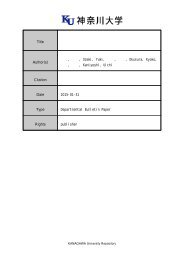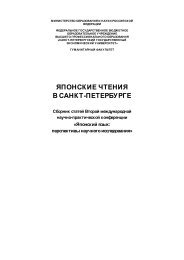to Learners with Special Educational Needs
e-textbook SEN
e-textbook SEN
Create successful ePaper yourself
Turn your PDF publications into a flip-book with our unique Google optimized e-Paper software.
Pokrivčáková, S. et al. (2015). Teaching Foreign Languages <strong>to</strong> <strong>Learners</strong> <strong>with</strong> <strong>Special</strong> <strong>Educational</strong> <strong>Needs</strong>:<br />
e-textbook for foreign language teachers. Nitra: Constantine the Philosopher University. 128 p.<br />
ISBN 978-80-558-0941-0<br />
c) Poetic action (action narration, alter-ego, analogy, behind the scene, caption-making,<br />
ceremony, come on down!, cross-cutting, documentary, flashback, folk-forms, forum-theatre,<br />
gestus, masks, metamorphosis, mimed activity, montage, play <strong>with</strong>in a play, prepared roles,<br />
re-enactment, revue, ritual, role-reversal, shape-shifting, small-group play-making,<br />
soundscape, TV Times);<br />
d) Reflective Action (choral speak, gestalt, giving witness, group sculpture, If I was you…,<br />
marking the moment, moment of truth, narration, space between, spectrum of difference,<br />
taking sides, this way/that way, thought-tracking, voices in the head, walls have ears).<br />
Defining the terms<br />
- drama in EFL is a complex method using drama techniques and conventions; it is a wholeperson<br />
approach <strong>to</strong> language teaching and it requires us <strong>to</strong> look at communication<br />
holistically.<br />
- drama techniques are activities, many of which are based on techniques used by ac<strong>to</strong>rs in<br />
their training. Through them, students are given opportunities <strong>to</strong> use their own personality in<br />
creating the material on which part of the language class is based.<br />
- language learning strategies are the processes and actions consciously deployed by<br />
language learners <strong>to</strong> help them <strong>to</strong> learn a language more effectively.<br />
- constructivist approach believes that learning occurs when the learners are actively<br />
involved in the learning process and create their knowledge in the process.<br />
- holistic learning is a type of learning that focuses on the whole picture and not only the<br />
splinters or puzzle pieces <strong>with</strong>in a <strong>to</strong>pic, thus, it is easier for majority of SEN children who<br />
tend <strong>to</strong> need <strong>to</strong> see the whole picture first.<br />
- situated learning is experiential learning in a meaningful situation<br />
- multisensory approach – using as many senses as possible <strong>to</strong> improve the learning process<br />
of SEN learners<br />
- social aspects of SEN describe the feelings and challenges that the child <strong>with</strong> special<br />
educational needs faces<br />
2. Australia – multisensory structured drama approach (Teaching language and<br />
content using drama techniques and conventions)<br />
I decided <strong>to</strong> demonstrate structured drama approach on using a simplified reader (Australia<br />
and New Zealand by Christine Lindop, Oxford Bookworms, level 3). The project of this<br />
structured drama is based on situated learning, which uses experiential learning in a meaningful<br />
context where the rule is that our learning is led by the harmony between our experiences and<br />
the experiences of the others in the classroom (Krátká, 2011). The experience becomes<br />
educationally significant when the learners identify themselves <strong>with</strong> the characters, and on the<br />
basis of their reflection in the role of the character as well as their own reflection the learners<br />
gain new social and emotional experiences (Silberman, 2007).<br />
Author of the lesson: Šárka Dohnalová<br />
Time needed: 2 <strong>to</strong> 8 sessions depending how deep we want <strong>to</strong> get in<strong>to</strong> the <strong>to</strong>pic and what the<br />
students want <strong>to</strong> research.<br />
Age group: 6 th grade and older<br />
<strong>Educational</strong> area: Humans and their world; Humans and communication; Cross-curricular<br />
links;<br />
Outputs according <strong>to</strong> the <strong>Educational</strong> Framework of Reference:<br />
The pupil recognizes the main information, past and contemporary, of Australia as the<br />
continent, its inhabitants, riches and poverties;<br />
The pupil uses texts, encyclopaedias, the Internet as their sources of information for<br />
understanding the <strong>to</strong>pic;<br />
Using the selected texts the pupil compares and evaluates the way of life of the Australian<br />
past inhabitants (both: first the Aborigines, then the convicts coming from England) and the<br />
contemporary inhabitants and their way of life.<br />
103






